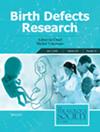Choosing Words to Limit Stigma: The Use of Person-First Language in Birth Defects Research
Abstract
Background
Birth defects are associated with psychosocial stress and stigma, in addition to increased mortality and lifelong disabilities. The language and phrasing used to describe individuals with birth defects in scientific writing can affect attitudes that contribute to stigma. Using a “person-first” writing structure (e.g., “infants with Down syndrome”) instead of “identity-first” language (e.g., “Down syndrome infants”) is intended to promote respect and inclusivity. Our work aims to enhance awareness and advocacy of person-first language among researchers and professionals in birth defects research, with the goal of reducing stigma and adopting language that prioritizes dignity for individuals and their families.
Methods
We analyzed 52 population-based birth defects articles published by the National Birth Defects Prevention Network (NBDPN) between 2002 and 2024, which we expect to exemplify writing practices among U.S. birth defects epidemiologists. We evaluated the use of person-first and identity-first language in population-based birth defects research and advocated for increased consideration of person-first language in the field.
Results
Among 52 NBDPN articles reviewed, seven (13%) articles used person-first language only, N = 6 (12%) used identity-first language only, 38 (73%) used both, and one (2%) used neither.
Conclusion
We encourage researchers to consider using person-first language when describing individuals with birth defects in epidemiologic studies and in training birth defects epidemiologists, while acknowledging that some communities may also prefer an identity-first framework (e.g., the “Deaf community”).

 求助内容:
求助内容: 应助结果提醒方式:
应助结果提醒方式:


